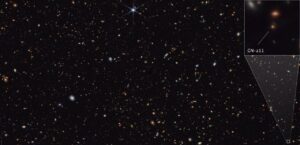
We live during a great time to be a cosmologist. Between the availability of computer processing and the completion of JWST, we can both see more and model more than ever before, and this ability is giving us both observational snapshots of our changing universe and the computational ability to figure out what happened between frames.
On the observational side of discovery, two new pieces of data caught my eye.
A pair of papers accepted into Nature and Astronomy & Astrophysics and led by Roberto Maiolino have found the stuff of Population III stars, those near-mythical first-generation stars made of primordial material – basically hydrogen and helium – and nothing else.
While conducting the JWST Advanced Deep Extragalactic Survey, or JADES, researchers found an actively feeding black hole at the center of a baby galaxy cataloged as GN-z11 — a baby galaxy shining from when the universe was just 430 million years old.
Like many supermassive black holes, this one is a messy eater, and JWST detected a cloud outside the galaxy rich in helium… and maybe not much else. According to Maiolino, “The fact that we don’t see anything else beyond helium suggests that this clump must be fairly pristine. This result was expected by theory and simulations in the vicinity of particularly massive galaxies from these epochs — that there should be pockets of pristine gas surviving in the halo, and these may collapse and form Population III star clusters.”
This means that we have now found Population II stars that appear to be born from material enriched by a single supernova, and we have found the pristine gas that can form Population III stars. While it was hoped JWST would finally find Population III stars, that hope is not supported by a trail of evidence saying “somewhere in all this data, your stars are hiding… so keep looking.”
According to an ESA press release, Maiolino and the JADES team will continue their research of GN-z11 and keep looking for signs of stars buried in all the beautifully pristine gas.
